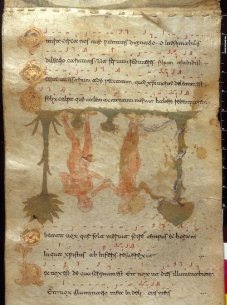 |
|
Paleography
Exercises |
|
Exultet
Roll, late 11th century Italian (British Library add ms 30337). All
images by permission of the British Library.
These images are made available under a Creative Commons licence. |
|
 |
This is just a small section of an exultet roll, which was until the late 19th century in the abbey of Montecassino. The roll is 22 feet long (c.7 meters), and is made up of 12 parchment membranes joined together. The illustration in this section shows Eve tempting Adam with the fruit, while the serpent wraps itself around her legs. The Latin text, which includes musical notation, is upside down with respect to the picture, as it was read and sung by the deacon on one side of the lectern while the pictures were viewed by the congregation on the other side during the Easter services. The text is an Easter hymn acclaiming the resurrection of Christ and was sung at the consecration of the Paschal candle. Particularly charming is the scene further down the roll with a scene of beekeeping, as the bees are commended for their contribution of the beeswax for the candles. The script of the text is Beneventan in the style typical of Montecassino. |
|
overview | illustration | text | alphabet
| abbreviations | ligatures
| exercises |
transcript
| translation
|
|
Click
on each of the above to walk your way through a segment of the text. The
transcript will appear in a separate window so that you can use it for
reference at any time. These exercises are designed to guide you through
the text, not test you, so you can cheat as much as you like. |
 Script sample for this example Script sample for this example |
 Index
of Exercises Index
of Exercises |
 Index
of Scripts Index
of Scripts |
|
 |
|